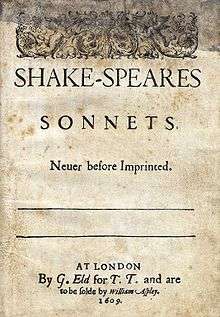Sonnet 143
Sonnet 143 is one of 154 sonnets written by the English playwright and poet William Shakespeare.
| Sonnet 143 | |||||||
|---|---|---|---|---|---|---|---|
 Sonnet 143 in the 1609 Quarto | |||||||
| |||||||
Structure
Sonnet 143 is an English or Shakespearean sonnet. The English sonnet has three quatrains, followed by a final rhyming couplet. It follows the typical rhyme scheme of the form ABAB CDCD EFEF GG and is composed in iambic pentameter, a type of poetic metre based on five pairs of metrically weak/strong syllabic positions. The 7th line exemplifies a regular iambic pentameter:
× / × / × / × / × / To follow that which flies before her face, (143.7)
- / = ictus, a metrically strong syllabic position. × = nonictus.
Line 2 begins with a common metrical variation, an initial reversal:
/ × × / × / × / × / One of her feather'd creatures broke away, (143.2)
Initial reversals occur in lines 2 and 6, and potentially in lines 1, 3, 5, and 13. Several phrases which might imply a metrical variant in other contexts are rendered doubtful in this poem because of the frequency with which contrastive accent on pronouns is suggested by both the nature of the story and the meter. For example, line 5 is capable of both an initial and a mid-line reversal:
/ × × / × / / × × / Whilst her neglected child holds her in chase, (143.5)
However, the story's emphasis on pronouns may render a regular reading more likely:
× / × / × / × / × / Whilst her neglected child holds her in chase, (143.5)
Similarly line 12's "kiss me" — which in most contexts would reverse the ictus to the tonic stress of "kiss" — might here retain a regular rhythm by implying contrastive accent on "me". Lines 8 and 12 may also suggest accentuated pronouns which maintain a regular rhythm.
The meter demands line 4's "pursuit" be stressed on the first syllable.[2]
Notes
- Pooler, C[harles] Knox, ed. (1918). The Works of Shakespeare: Sonnets. The Arden Shakespeare [1st series]. London: Methuen & Company. OCLC 4770201.
- Groves, Peter (2013). Rhythm and Meaning in Shakespeare: A Guide for Readers and Actors. Melbourne: Monash University Publishing. p. 169. ISBN 978-1-921867-81-1.
References
- First edition and facsimile
- Shakespeare, William (1609). Shake-speares Sonnets: Never Before Imprinted. London: Thomas Thorpe.CS1 maint: ref=harv (link)
- Lee, Sidney, ed. (1905). Shakespeares Sonnets: Being a reproduction in facsimile of the first edition. Oxford: Clarendon Press. OCLC 458829162.
- Variorum editions
- Alden, Raymond Macdonald, ed. (1916). The Sonnets of Shakespeare. Boston: Houghton Mifflin Company. OCLC 234756.
- Rollins, Hyder Edward, ed. (1944). A New Variorum Edition of Shakespeare: The Sonnets [2 Volumes]. Philadelphia: J. B. Lippincott & Co. OCLC 6028485.
- Modern critical editions
- Atkins, Carl D., ed. (2007). Shakespeare's Sonnets: With Three Hundred Years of Commentary. Madison: Fairleigh Dickinson University Press. ISBN 978-0-8386-4163-7. OCLC 86090499.
- Booth, Stephen, ed. (2000) [1st ed. 1977]. Shakespeare's Sonnets (Rev. ed.). New Haven: Yale Nota Bene. ISBN 0-300-01959-9. OCLC 2968040.
- Burrow, Colin, ed. (2002). The Complete Sonnets and Poems. The Oxford Shakespeare. Oxford: Oxford University Press. ISBN 978-0192819338. OCLC 48532938.
- Duncan-Jones, Katherine, ed. (2010) [1st ed. 1997]. Shakespeare's Sonnets. The Arden Shakespeare, Third Series (Rev. ed.). London: Bloomsbury. ISBN 978-1-4080-1797-5. OCLC 755065951.
- Evans, G. Blakemore, ed. (1996). The Sonnets. The New Cambridge Shakespeare. Cambridge: Cambridge University Press. ISBN 978-0521294034. OCLC 32272082.
- Kerrigan, John, ed. (1995) [1st ed. 1986]. The Sonnets ; and, A Lover's Complaint. New Penguin Shakespeare (Rev. ed.). Penguin Books. ISBN 0-14-070732-8. OCLC 15018446.
- Mowat, Barbara A.; Werstine, Paul, eds. (2006). Shakespeare's Sonnets & Poems. Folger Shakespeare Library. New York: Washington Square Press. ISBN 978-0743273282. OCLC 64594469.
- Orgel, Stephen, ed. (2001). The Sonnets. The Pelican Shakespeare (Rev. ed.). New York: Penguin Books. ISBN 978-0140714531. OCLC 46683809.
- Vendler, Helen, ed. (1997). The Art of Shakespeare's Sonnets. Cambridge, MA: The Belknap Press of Harvard University Press. ISBN 0-674-63712-7. OCLC 36806589.
.png)
